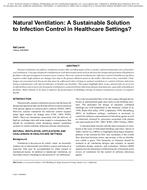Click here to purchase
The majority of human exposure to airborne particles occurs inside buildings, particularly in residences. In order to improve indoor air quality and reduce indoor particle concentrations, high efficiency particle filters in central forced air heating, ventilating, and air-conditioning (HVAC) systems are increasingly being used. ASHRAE Standard 52.2 contains the most widely used method of evaluating the performance of HVAC filters in the U.S., but the standard only assesses the removal efficiency of particles 0.3-10 um in diameter. However, the vast majority of particles in any indoor or outdoor environment (by number) are less than 0.1 um in diameter, or ultrafine particles (UFPs), which have been shown to provoke alveolar inflammation and consequently intensify heart and lung disease. Further, the 52.2 test procedure is also limited only to laboratory testing and does not provide information about the performance of HVAC filters in real environments. Therefore in this project, an in-situ test method is used to measure the particle removal efficiency of a wide range of commercially available filters in 20 particle size ranges from 0.01-2.5 um in diameter. The test procedure involves measuring particle concentrations upstream and downstream of an HVAC filter installed in a residential air-handling unit. The size-resolved particle removal efficiency for each size bin is calculated by subtracting the average ratio of downstream-to-upstream pollutant concentrations from unity. A combination of a TSI NanoScan SMPS and a TSI Optical Particle Sizer is used with an automated electronically actuated switching valve to measure particle concentrations. We also characterize the impacts of filter pressure drop on system airflow rates using a flow plate device. Measurements are conducted in a controlled and unoccupied residential apartment unit located in a graduate student residence hall on the main campus of Illinois Institute of Technology. More than a dozen filters with various minimum efficiency rating values (MERV) from a variety of manufacturers have been tested thus far and we are beginning to develop an online database of these results for engineers and homeowners to use.
Citation: 2016 Winter Conference, Orlando, FL, Conference Papers
Product Details
- Published:
- 2016
- Number of Pages:
- 8
- Units of Measure:
- Dual
- File Size:
- 1 file , 1.9 MB
- Product Code(s):
- D-OR-16-C025


